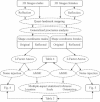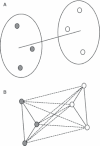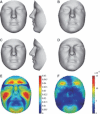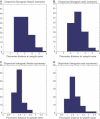Sexual dimorphism in multiple aspects of 3D facial symmetry and asymmetry defined by spatially dense geometric morphometrics
- PMID: 22702244
- PMCID: PMC3406357
- DOI: 10.1111/j.1469-7580.2012.01528.x
Sexual dimorphism in multiple aspects of 3D facial symmetry and asymmetry defined by spatially dense geometric morphometrics
Abstract
Accurate measurement of facial sexual dimorphism is useful to understanding facial anatomy and specifically how faces influence, and have been influenced by, sexual selection. An important facial aspect is the display of bilateral symmetry, invoking the need to investigate aspects of symmetry and asymmetry separately when examining facial shape. Previous studies typically employed landmarks that provided only a sparse facial representation, where different landmark choices could lead to contrasting outcomes. Furthermore, sexual dimorphism is only tested as a difference of sample means, which is statistically the same as a difference in population location only. Within the framework of geometric morphometrics, we partition facial shape, represented in a spatially dense way, into patterns of symmetry and asymmetry, following a two-factor anova design. Subsequently, we investigate sexual dimorphism in symmetry and asymmetry patterns separately, and on multiple aspects, by examining (i) population location differences as well as differences in population variance-covariance; (ii) scale; and (iii) orientation. One important challenge in this approach is the proportionally high number of variables to observations necessitating the implementation of permutational and computationally feasible statistics. In a sample of gender-matched young adults (18-25 years) with self-reported European ancestry, we found greater variation in male faces than in women for all measurements. Statistically significant sexual dimorphism was found for the aspect of location in both symmetry and asymmetry (directional asymmetry), for the aspect of scale only in asymmetry (magnitude of fluctuating asymmetry) and, in contrast, for the aspect of orientation only in symmetry. Interesting interplays with hypotheses in evolutionary and developmental biology were observed, such as the selective nature of the force underpinning sexual dimorphism and the genetic independence of the structural patterns of fluctuating asymmetry. Additionally, insights into growth patterns of the soft tissue envelope of the face and underlying skull structure can also be obtained from the results.
© 2012 The Authors. Journal of Anatomy © 2012 Anatomical Society.
Figures









Similar articles
-
The relationship between sexual dimorphism in human faces and fluctuating asymmetry.Proc Biol Sci. 2004 May 7;271 Suppl 4(Suppl 4):S233-6. doi: 10.1098/rsbl.2003.0146. Proc Biol Sci. 2004. PMID: 15252993 Free PMC article.
-
Using data-driven phenotyping to investigate the impact of sex on 3D human facial surface morphology.J Anat. 2023 Aug;243(2):274-283. doi: 10.1111/joa.13866. Epub 2023 Mar 21. J Anat. 2023. PMID: 36943032 Free PMC article.
-
Spatially-dense 3D facial asymmetry assessment in both typical and disordered growth.J Anat. 2011 Oct;219(4):444-55. doi: 10.1111/j.1469-7580.2011.01411.x. Epub 2011 Jul 11. J Anat. 2011. PMID: 21740426 Free PMC article.
-
Facial surface analysis by 3D laser scanning and geometric morphometrics in relation to sexual dimorphism in cerebral--craniofacial morphogenesis and cognitive function.J Anat. 2005 Sep;207(3):283-95. doi: 10.1111/j.1469-7580.2005.00444.x. J Anat. 2005. PMID: 16185253 Free PMC article. Review.
-
Sexual Dimorphism and Species Diversity: from Clades to Sites.Trends Ecol Evol. 2020 Feb;35(2):105-114. doi: 10.1016/j.tree.2019.09.001. Epub 2019 Oct 14. Trends Ecol Evol. 2020. PMID: 31623865 Review.
Cited by
-
Statistical Shape Modeling of Skeletal Anatomy for Sex Discrimination: Their Training Size, Sexual Dimorphism, and Asymmetry.Front Bioeng Biotechnol. 2019 Nov 1;7:302. doi: 10.3389/fbioe.2019.00302. eCollection 2019. Front Bioeng Biotechnol. 2019. PMID: 31737620 Free PMC article.
-
Was facial width-to-height ratio subject to sexual selection pressures? A life course approach.PLoS One. 2021 Mar 12;16(3):e0240284. doi: 10.1371/journal.pone.0240284. eCollection 2021. PLoS One. 2021. PMID: 33711068 Free PMC article.
-
Facial asymmetry and midsagittal plane definition in 3D: A bias-free, automated method.PLoS One. 2023 Nov 27;18(11):e0294528. doi: 10.1371/journal.pone.0294528. eCollection 2023. PLoS One. 2023. PMID: 38011159 Free PMC article.
-
Three-dimensional analysis of shape variations and symmetry of the fibula, tibia, calcaneus and talus.J Anat. 2019 Jan;234(1):132-144. doi: 10.1111/joa.12900. Epub 2018 Nov 4. J Anat. 2019. PMID: 30393864 Free PMC article.
-
Establishing a multidisciplinary context for modeling 3D facial shape from DNA.PLoS Genet. 2014 Nov 6;10(11):e1004725. doi: 10.1371/journal.pgen.1004725. eCollection 2014 Nov. PLoS Genet. 2014. PMID: 25375363 Free PMC article. No abstract available.
References
-
- Ackermann RR, Cheverud JM. Phenotypic covariance structure in tamarins (Genus Saguinys): a comparison of variation patterns using matrix correlation and common principal component analysis. Am J Phys Anthropol. 2000;111:489–501. - PubMed
-
- Adams D. Morphmet. 2011. Re: tribulations with permutations. available at http://www.mail-archive.com/morphmet@morphometrics.org/msg02265.html.
-
- Adams DC, Rohlf F, Slice D. Geometric morphometrics: ten years of progress following the revolution. Ital J Zool. 2004;71:5–16.
-
- Aeria G, Claes P, Vandermeulen D, et al. Targeting specific facial variation for different identification tasks. Forensic Sci Int. 2010;201:118–124. - PubMed
-
- Anderson JM. Permutation tests for univariate or multivariate analysis of variance and regression. Can J Fish Aquat Sci. 2001a;58:626–639.
Publication types
MeSH terms
LinkOut - more resources
Full Text Sources

